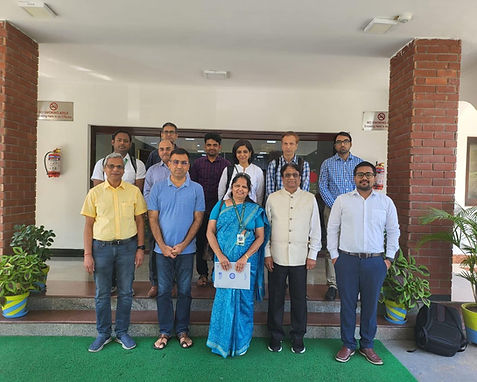Publications From Our Labs
Our world class research publications help the larger objective of global development in the field of Quantum communications. Access them here.

DOP- 10/11/2021 Journal- International Journal of Theoretical Physics Abstract- In this paper, we propose a new theoretical scheme for quantum secure direct communication (QSDC) with user authentication. Different from the previous QSDC protocols, the present protocol uses only one orthogonal basis of single-qubit states to encode the secret message. Moreover, this is a one-time and one-way communication protocol, which uses qubits prepared in a randomly chosen arbitrary basis, to transmit the secret message. We discuss the security of the proposed protocol against some common attacks and show that no eavesdropper can get any information from the quantum and classical channels. We have also studied the performance of this protocol under realistic device noise. We have executed the protocol in IBMQ Armonk device and proposed a repetition code-based protection scheme that requires minimal overhead.
Link
DOP- 26/07/2022
Journal- Quantum Information Processing
Abstract- Quantum secure direct communication (QSDC) and deterministic
secure quantum communication (DSQC) are two important branches of
quantum cryptography, where one can transmit a secret message securely
without encrypting it by a prior key. In the practical scenario, an
adversary can apply detector-side-channel attacks to get some
non-negligible amount of information about the secret message.
Measurement-device-independent (MDI) quantum protocols can remove this
kind of detector-side-channel attack, by introducing an untrusted third
party (UTP), who performs all the measurements during the protocol with
imperfect measurement devices. In this paper, we put forward the first
MDI-QSDC protocol with user identity authentication, where both the
sender and the receiver first check the authenticity of the other party
and then exchange the secret message. Then we extend this to an MDI
quantum dialogue (QD) protocol, where both the parties can send their
respective secret messages after verifying the identity of the other
party. Along with this, we also report the first MDI-DSQC protocol with
user identity authentication. Theoretical analyses prove the security of
our proposed protocols against common attacks.
Link

DOP- 01/01/2021
Journal- Quantum Information and computation
Abstract- Quantum conference is a proces s of securely exchanging
messages between three or more parties, using quantum resources. A
Measurement Device Independent Quantum Dialogue (MDI-QD) protocol, which
is secure against information leakage, has been proposed (Quantum
Information Processing 16.12 (2017): 305) in 2017, is proven to be
insecure against intercept-and-resend attack strategy. We first modify
this protocol and generalize this MDI-QD to a three-party quantum
conference and then to a multi-party quantum conference. We also propose
a protocol for quantum multi-party XOR computation. None of these three
protocols proposed here use entanglement as a resource and we prove the
correctness and security of our proposed protocols.

DOP- 11/11/2022
Journal- IEEE Xplore
Abstract- An important idea in quantum networks is that of employing
virtual edges or “short-cuts” between quantum nodes. These edges, which
are shared entangled pairs between two nodes that are not directly
connected “physically”, are expected to reduce the average latency of
entanglement distribution in quantum network routing. In this work, we
show how to create such edges on an existing discrete event simulator
for quantum networks called SeQUeNCe and study the impact that these
edges have on latency. Additionally, we implement a distributed routing
algorithm on the simulator and demonstrate its use in conjunction with
the virtual edges. We observe a reduction in latency when short cuts are
used, as is expected. Thus, with these modifications, we believe that
SeQUeNCe (and other similar simulators) can be used for experimenting
with advanced quantum networking protocols.

DOP- 11/11/2022
Journal- IEEE Xplore
Abstract- Quantum routing protocols seek to distribute entanglement
across different nodes of a quantum network. A recently popular approach
for quantum routing is to cut down the latency times for sharing
entanglement by using virtual edges in addition to physical ones. While
a physical edge is associated with the presence of a quantum channel,
virtual edges correspond to pre-existing entanglement between some nodes
which can be leveraged for entanglement swapping. Distributed routing
protocols for quantum networks have been proposed and analyzed using
this idea. These analyses have also been backed up by simulations.
However, to the best of our knowledge, existing simulation approaches
consider a static picture, where the demands for entangled pairs are
presented upfront. In this paper, we study routing algorithms through
time-driven simulations. Such an approach allows for the demands to
emerge in real-time as the simulation proceeds, and therefore mimic
realistic scenarios better. This also facilitates studying routing
protocols in the presence of dynamic replenishment of entangled pairs
and exposes issues like occurrence of deadlocks in the context of
limited quantum resources. As a demonstration of the approach, we show
simulation results that analyze the performance of various physical and
virtual graph topologies in terms of average latency time. Finally, we
show the change in performance and network saturation in the presence of
replenishment of entanglement resources.
